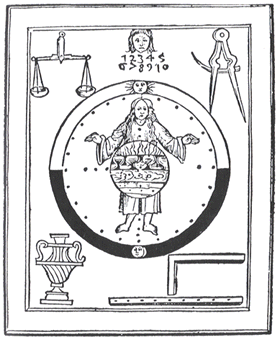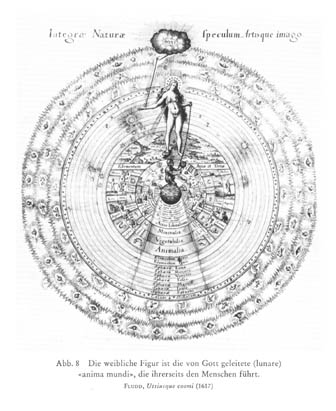4.5 The relationship between the ego, the Anima, the
Self and the anima mundi
4.5.3
Natural science and modern depth psychology as split
from
the wholeness of the anima
mundi of the Medieval Ages
 Before
we can go on, we must now define the term anima
mundi or world soul (see picture on the right). As I have shown in Wolfgang
Pauli und die Wiederkehr der Weltseele (in German), in the
Medieval Ages one of the most important aspects of the world
soul was the idea of the anima
movens, the moving soul. It was this aspect, which produced
the motion of the planets – and in fact any motion. The world
soul was everywhere, in any part of the universe. However, it
was also the soul of the whole. Thus, the part and the whole
were identical; what happened in the microcosm had also happened
in the macrocosm et vice versa. Like this, the world soul was
the ligament between the part and the whole which were in fact
one and the same thing.
Before
we can go on, we must now define the term anima
mundi or world soul (see picture on the right). As I have shown in Wolfgang
Pauli und die Wiederkehr der Weltseele (in German), in the
Medieval Ages one of the most important aspects of the world
soul was the idea of the anima
movens, the moving soul. It was this aspect, which produced
the motion of the planets – and in fact any motion. The world
soul was everywhere, in any part of the universe. However, it
was also the soul of the whole. Thus, the part and the whole
were identical; what happened in the microcosm had also happened
in the macrocosm et vice versa. Like this, the world soul was
the ligament between the part and the whole which were in fact
one and the same thing.
It
is this idea, which is so difficult to understand for modern
man. We are so used to thinking of ourselves as a part
interacting with other parts completely distinct from us that we
cannot feel anymore that we all together, all these single
particles, could perhaps also be a unity, a wholeness, of one
and the same living organism.
For
Medieval man this was completely different. Since he felt
himself as the microcosm and the world or even the cosmos as the
macrocosm, and for him the part was identical with the whole,
the anima mundi was
– in the terminology of today – also the connection between
the inner and the outer world. However, we must always bear in
mind that such a distinction between inside and outside was not
even thinkable for Medieval man. Thus, also the individual and
the collective soul were one and the same.
Further,
the world soul was also the ligament between spirit and matter.
However, also such a terminology is in some way misleading,
since spirit, matter and soul were also one and the same thing
– the anima mundi.
We
can thus define the Medieval world soul in our modern
terminology as a wholeness that comprises spirit, psyche and
matter, the part and the whole, as well as the inner and the
outer world. Its main principle was the idea of
the connection of everything with everything, since on the one
hand all parts are contained in the whole and the whole in all
parts. The same is true for man’s inner world and the outer
world, for the microcosm and the macrocosm. Further, the spirit
was contained in the psyche, the psyche in matter, and matter in
the spirit. We must however keep in mind that the Medieval man
would not have described this fact in these terms, since the
word “connection” – the interaction in modern physics –
was not yet defined in the way we use it today, i.e., as an
energetical principle qualitatively distinct from matter. What
we call on the one hand “matter” and what we name on the
other as “force” or “interaction”, was thus still one
and the same thing; the “body of matter” and the “soul of
matter” were just the same, the world soul.
 With
the development of Kepler’s laws governing the motion of the
planets at the beginning of the 17th century
mathematics entered natural philosophy. It allowed the
description of the motion of a single part, e.g., of a specific
planet. The idea of a ligament of love, the anima
movens aspect of the mysterious divine world soul, was not
necessary anymore for the explanation of the planets’ motions.
Thus the connection between the celestial bodies was now not
described by the principle of Eros anymore. Mathematics, i.e.,
the principle of Logos, explained now the motions of the bodies
in the sky, and the divine ligament of the part and the whole,
the anima movens, the background of all motion in the sky, became
useless and worthless [see picture on the left (out of CW 12, p.
47; Carl Jung published the image at the beginning of his
interpretation of Wolfgang Pauli's dreams...!)].
With
the development of Kepler’s laws governing the motion of the
planets at the beginning of the 17th century
mathematics entered natural philosophy. It allowed the
description of the motion of a single part, e.g., of a specific
planet. The idea of a ligament of love, the anima
movens aspect of the mysterious divine world soul, was not
necessary anymore for the explanation of the planets’ motions.
Thus the connection between the celestial bodies was now not
described by the principle of Eros anymore. Mathematics, i.e.,
the principle of Logos, explained now the motions of the bodies
in the sky, and the divine ligament of the part and the whole,
the anima movens, the background of all motion in the sky, became
useless and worthless [see picture on the left (out of CW 12, p.
47; Carl Jung published the image at the beginning of his
interpretation of Wolfgang Pauli's dreams...!)].
Johannes
Kepler’s discovery of the laws of planetary motion was thus an
incredibly deep revolution with two extremely grave effects.
First the unity of the planets and the universe, their vinculum
amoris (band of love), and second the emotional ligament
between man and the universe was destroyed. Up until this
decisive moment the
“inner movement” of the mystical experience
of wholeness, the “e-motion” of the unity of the “part”
with the deity, a principle belonging to the Eros, was the
background of the relationship of the ego with the universe. Now
however, after Johannes Kepler, it was the mathematical law that
described outer
motion.
The original unity of (inner) movement and (outer) motion was
cut off, since the former continued to belong to the principle
of Eros, the latter however became a content of the slowly
dawning principle of Logos.
Of
course such a development encouraged also the split in Descartes
(1596 – 1650). This philosopher lived two and a half decades
after Kepler (1571
– 1630) and was raised in
monasteries without any feminine and maternal background. He invented the sharp separation between the inner and the
outer world and like this split the world soul. Further, with
his concept of the distinction of the res
cogitans – I call this principle the spirit-psyche – ,
from the res extensa, i.e., inanimate matter, he was in fact also the
initiator of the repression of the second principle of the
bipolar energy term, the matter-psyche.
Like this also the consciousness of the Medieval man, the
res amans, the Eros
ego, and his view of the energetical processes in matter, the res
intensa, disappeared from the description of the natural
world.
As
we have seen, the world soul was also the unity of what we call
today spirit, psyche and matter. With the split into inner and
outer world and the one-sided definition of the inner world as
spirit-psyche (res cogitans) and the outer as “spirit-matter” (the inanimate
matter or res extensa),
a further one-sided concept conquered natural science: The
qualitative difference between energy or force and matter. It
was now easy to describe the active masculine part of the world
as the principle of energy or force, the passive and feminine
part as matter. The idea that this passive matter could also be
or contain an original force or energy however vegetative and
mathematically not describable – the matter-psyche – was
repressed.
Since
with Johannes Kepler and Isaac Newton it became possible to
describe and even to manipulate (outer) motion with the help of
causal mathematics, the belief arouse that the whole world is
deterministic. This means that if we can determine the initial
conditions of a motion, we can in every moment calculate all the
further states. A logical effect of such a development was of
course the repression of the postulate that the world soul could
be able to create spontaneous, acausal events
following the principle of the creatio
continua.
Thus, the idea of the “cheerless clockwork” (Carl Jung), the
causal materialistic world view valid for the description of the
outer as well as for the inner world, was born.
At
the beginning of the 20th century, the idea of the
self-reliance of the soul came back – of course in
stercore. Sigmund Freud re-discovered a specific aspect of
the soul – in my terminology the inner spirit-psyche –
in what he called the subconscious. Its energetical
principle, the libido (as he called the inner spirit-psyche),
was in his view connected to the most repressed instinct, to
sexuality. Carl Jung extended this background of the repressed
individual soul, the individual spirit-psyche, first with the
idea that the libido is not only an aspect of sexuality, but of
all instincts, and especially also of our mind. Further, he
extended the concept to the so-called collective unconscious
with its center, the Self. In his view the human mind is based
on the archetype of the spirit – in my terminology on the
spirit-psyche – and, as we have seen, the connection of the
conscious spirit-psyche, the mind, with the collective
spirit-psyche, the Self, is established by dreams, visions and
Active Imagination.
Thus,
one could assume that Carl Jung with the collective unconscious
and its center, the Self, has re-discovered the world soul.
However, as we have seen, his Self – I call it the Logos Self
– contains only one aspect of the psyche, the (inner)
spirit-psyche. Thus the matter-psyche, alchemically seen, the
dew or the seeds in the earth, the other aspect of the bipolar
world soul, is not included. The depth psychologist’s bright
Logos Self outshines the matter-psyche, the latter becoming like
this the shadow of Jung’s Self. Since this principle has a lot
to do with “e-motion”, feeling and the connection principle
in general, and since it is the looked-for “procreative nature of the Whole” (Carl Jung)
behind the human/animal sexual drive, I call the shadow of Jung’s Self, the Eros Self.
We can now summarize the
insights about the world soul. Up until the 17th
century natural philosophy and in fact the whole background of
psychic life was determined by the anima
mundi. The world soul was some sort of the divine
energetical principle of the microcosm and of the macrocosm.
Using my terms we can postulate that the world soul was a unity,
containing the bipolarity of the inner and outer spirit-psyche
as well as the bipolarity of the spirit-psyche and the
matter-psyche
and last but not least the “trinity” of spirit, matter and
psyche (soul).